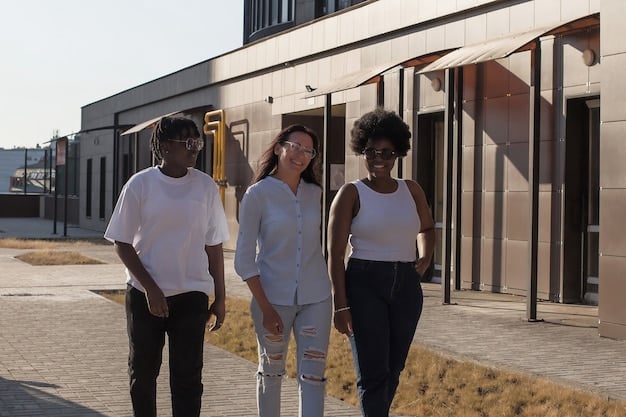Analyzing Impact: Supreme Court & Affirmative Action in Higher Ed

Analyzing the Impact of Recent Supreme Court Rulings on Affirmative Action Policies in Higher Education involves examining how these decisions are reshaping college admissions, diversity efforts, and equal opportunity in the United States.
The recent Supreme Court rulings on affirmative action have sent shockwaves through the landscape of higher education. The implications of these decisions are far-reaching, fundamentally altering how colleges and universities consider race in their admissions processes. Analyzing the Impact of Recent Supreme Court Rulings on Affirmative Action Policies in Higher Education is crucial for understanding the future of diversity and inclusion in the United States.
The Supreme Court’s Decision: A Summary
In June 2023, the Supreme Court effectively ended affirmative action in college admissions, ruling against the race-conscious admissions policies at Harvard University and the University of North Carolina. This decision has overturned decades of precedent that allowed colleges to consider race as one factor among many in evaluating applicants.
The court argued that these policies violated the Equal Protection Clause of the Fourteenth Amendment, which prohibits discrimination based on race. Chief Justice John Roberts wrote in the majority opinion that while universities can still consider how race has affected an applicant’s life, this must be tied to a quality or characteristic the applicant can contribute to the university.
Key Arguments and Dissent
The majority opinion emphasized the principle of equal treatment under the law, asserting that race should not be a determining factor in admissions. The justices argued that the policies at Harvard and UNC were not sufficiently linked to the permissible goals of diversity and lacked a clear endpoint.
In dissent, Justice Sonia Sotomayor argued that the court was undermining decades of progress in promoting racial diversity in higher education. She contended that the ruling ignores the persistent effects of systemic racism and the importance of considering race to achieve a truly equitable educational environment.
- Equal Protection Clause: The court’s interpretation of the Fourteenth Amendment.
- Diversity as a Goal: The debate over whether race-conscious admissions are necessary to achieve diversity.
- Systemic Racism: The dissenting justices’ argument that the ruling disregards the ongoing impact of racial inequality.

In conclusion, the Supreme Court’s decision represents a significant shift in the legal landscape of affirmative action. It has sparked widespread debate and raised important questions about the future of diversity and inclusion in higher education.
Immediate Reactions from Universities and Students
The immediate aftermath of the Supreme Court’s ruling saw a flurry of responses from universities and student organizations. Many institutions expressed disappointment but affirmed their commitment to finding alternative ways to maintain diverse student bodies. Student groups, particularly those representing minority communities, voiced concerns about the potential impact on campus diversity.
Universities quickly began exploring strategies to comply with the new legal requirements while still promoting diversity. These include increased outreach to underrepresented communities, a greater emphasis on socioeconomic factors in admissions, and a focus on holistic review processes that consider applicants’ life experiences.
Several universities issued statements emphasizing their commitment to creating inclusive environments and supporting students from all backgrounds. They acknowledged the challenges posed by the ruling but expressed determination to navigate the new legal landscape in a way that aligns with their values.
Student Perspectives
Students from various backgrounds shared their reactions to the ruling. Some expressed concerns that the decision would lead to a decline in diversity on college campuses, while others argued that it would promote a more merit-based system. The debate highlighted the complexity and sensitivity of the issue.
Student organizations organized discussions and forums to analyze the implications of the ruling and develop strategies for advocating for diversity and inclusion. They emphasized the importance of continued engagement and activism to ensure that all students have access to educational opportunities.
In conclusion, the immediate reactions from universities and students revealed a mix of disappointment, determination, and uncertainty about the future. The ruling has prompted a period of reflection and adaptation as institutions and individuals grapple with its implications.
Strategies for Maintaining Diversity Without Affirmative Action
With traditional affirmative action policies no longer permissible, colleges and universities are exploring alternative strategies to maintain diverse student bodies. These strategies include focusing on socioeconomic diversity, expanding outreach programs, and refining holistic review processes.
Many institutions are placing a greater emphasis on socioeconomic factors in admissions. This involves considering applicants’ family income, educational background, and neighborhood environment as indicators of their resilience and potential. By prioritizing socioeconomic diversity, colleges aim to create a more level playing field for students from disadvantaged backgrounds.
Colleges are also expanding their outreach programs to reach underrepresented communities. This includes partnering with high schools and community organizations to provide academic support, college counseling, and financial aid information to students who may not otherwise have access to these resources.
- Socioeconomic Diversity: Prioritizing students from low-income backgrounds.
- Expanded Outreach: Reaching underrepresented communities through targeted programs.
- Holistic Review: Considering applicants’ life experiences and personal qualities.
Holistic Review Processes
Holistic review involves considering applicants’ academic achievements, extracurricular activities, personal essays, and letters of recommendation to gain a comprehensive understanding of their strengths and potential. This approach allows admissions officers to assess applicants’ character, leadership skills, and commitment to service.
By implementing these strategies, colleges hope to maintain diverse student bodies and promote equal opportunity in higher education. However, the effectiveness of these approaches remains to be seen, and ongoing monitoring and evaluation will be crucial to ensure their success.
The challenge for universities is to uphold the principles of diversity and inclusion while adhering to the new legal framework. This requires a commitment to innovation, collaboration, and a deep understanding of the complex factors that contribute to educational inequality.
The Potential Impact on Different Racial and Ethnic Groups
The Supreme Court’s ruling on affirmative action is expected to have varying impacts on different racial and ethnic groups. Some experts predict that the decision will lead to a decline in the enrollment of Black and Hispanic students at selective colleges and universities, while others argue that alternative strategies can mitigate these effects.
Studies have shown that affirmative action policies have historically played a significant role in increasing the representation of underrepresented minority groups in higher education. Without these policies, some predict that these groups may face greater challenges in gaining admission to competitive institutions.
However, others argue that a focus on socioeconomic diversity and expanded outreach programs can help to level the playing field and ensure that talented students from all backgrounds have access to educational opportunities. The key will be to implement these strategies effectively and to monitor their impact over time.
The debate over the potential impact on different racial and ethnic groups highlights the complexity and sensitivity of the issue. It is essential to consider the perspectives of all stakeholders and to develop policies that promote fairness and equity.

Some also suggest that the ruling may lead to an increase in the enrollment of Asian American students at selective colleges, as race-conscious admissions policies have been criticized for discriminating against this group. However, the overall impact on Asian American enrollment remains uncertain.
In conclusion, the potential impact on different racial and ethnic groups is a complex and multifaceted issue. Ongoing research and monitoring will be essential to understand the long-term effects of the Supreme Court’s ruling and to develop strategies for promoting diversity and inclusion in higher education.
Legal and Political Challenges Moving Forward
The Supreme Court’s ruling on affirmative action is likely to face continued legal and political challenges moving forward. There are already discussions about potential legislative action to codify diversity standards in higher education, as well as legal challenges to admissions policies that are perceived as indirectly discriminating based on race.
Some civil rights organizations are exploring legal strategies to challenge admissions policies that they believe perpetuate racial inequality. These challenges may focus on issues such as legacy admissions, standardized testing requirements, and the allocation of financial aid resources.
On the political front, there is likely to be continued debate over the role of government in promoting diversity and inclusion in higher education. Some policymakers may seek to expand opportunities for underrepresented groups, while others may advocate for policies that emphasize merit-based admissions.
Legislative Action
There have been calls for Congress to pass legislation that would clarify the permissible goals of diversity in higher education and provide guidance to colleges and universities on how to comply with the Supreme Court’s ruling. However, the prospects for such legislation are uncertain, given the current political climate.
Regardless of the specific legal and political challenges that arise, it is clear that the debate over affirmative action will continue to be a central issue in American society. The Supreme Court’s ruling has opened a new chapter in this debate, and its long-term impact remains to be seen.
- Legislative Action: Potential congressional efforts to address the ruling.
- Legal Challenges: Lawsuits targeting admissions policies perceived as discriminatory.
- Political Debate: Ongoing discussions about the role of government in promoting diversity.
The Broader Implications for Social Justice and Equity
The Supreme Court’s ruling on affirmative action has broader implications for social justice and equity in the United States. Some argue that the decision undermines decades of progress in promoting racial equality, while others contend that it represents a step toward a more merit-based society.
The debate over affirmative action is closely linked to broader discussions about systemic racism and inequality. Those who support affirmative action argue that it is necessary to address the persistent effects of historical discrimination and to create a more level playing field for underrepresented groups.
Opponents of affirmative action argue that it is a form of reverse discrimination that unfairly advantages some groups over others. They contend that race-neutral policies are the best way to promote equality and opportunity for all.
The Supreme Court’s ruling has reignited these debates and raised important questions about the role of race in American society. It has also prompted a renewed focus on the need to address the root causes of inequality, such as poverty, inadequate education, and lack of access to healthcare.
In conclusion, the broader implications for social justice and equity are far-reaching and complex. The Supreme Court’s ruling has opened a new chapter in the ongoing struggle for equality in America. The challenge for policymakers, educators, and community leaders is to work together to create a society where everyone has the opportunity to succeed, regardless of their race or background.
| Key Point | Brief Description |
|---|---|
| ⚖️ Supreme Court Ruling | Affirmative action policies in higher education were effectively ended. |
| 🎓 University Responses | Universities are exploring new strategies for maintaining diversity. |
| 🌱 Alternative Strategies | Focus on socioeconomic diversity and expanded outreach programs. |
| 🌍 Social Justice | Implications for broader social justice and equity debates in the U.S. |
Frequently Asked Questions
The Supreme Court ruled against race-conscious admissions policies at Harvard University and the University of North Carolina, effectively ending affirmative action in college admissions.
The court argued that the policies violated the Equal Protection Clause of the Fourteenth Amendment, which prohibits discrimination based on race. They felt race shouldn’t be a determining factor.
Universities are exploring strategies to comply with the ruling while still promoting diversity; they’re focusing on socioeconomic factors and expanding outreach programs.
Alternative strategies for maintaining diversity include focusing on socioeconomic diversity, expanding outreach programs, and refining holistic review processes.
The ruling has implications for social justice and equity in the U.S., reigniting debates about systemic racism and the role of race in American society.
Conclusion
In conclusion, the Supreme Court’s recent rulings on affirmative action represent a significant turning point for higher education in the United States. As universities adapt to the new legal landscape, it is crucial to monitor the long-term effects of these decisions and to continue to advocate for policies that promote fairness, equity, and opportunity for all students.





